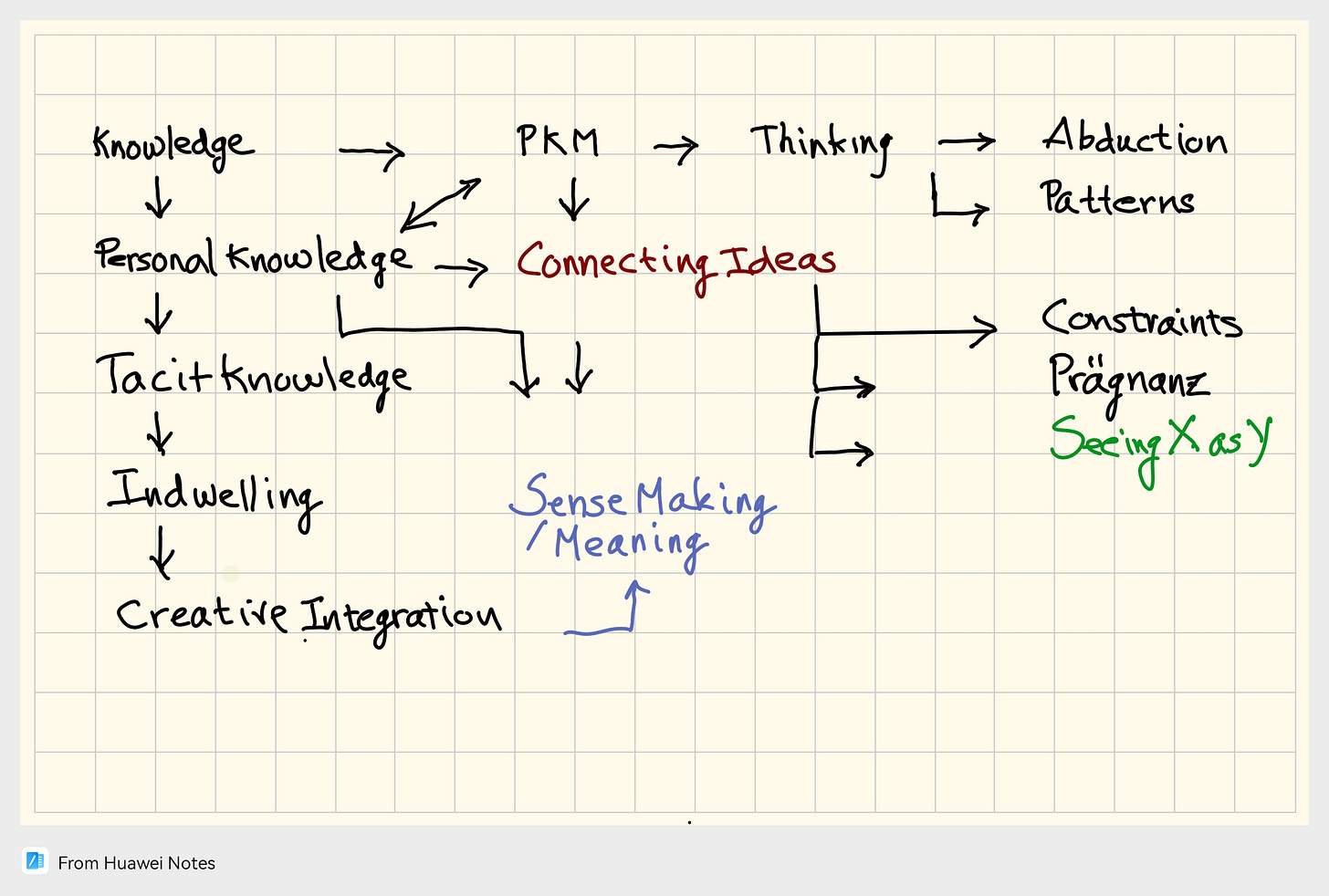Looking back at my past posts on my blog, extended-brain.substack.com, is like viewing a landscape from above. You can see the peaks and valleys, with many paths connecting them. There are also areas that form clusters or categories. It's not like I planned it all out perfectly; things just naturally grouped themselves into different categories as I went along. In so doing I have avoided falling into the trap of premature categorization.
The initial topics were about knowledge: the organization into Personal Knowledge Management System (PKMS), and the nature of Knowledge. I found this idea by Michael Polanyi really compelling – that knowledge is mostly "personal."
What Polanyi meant, in my understanding, is that knowledge is really about your own personal take on things. How you interpret something depends on what you already know and your experiences. When you add a new piece of information into your personal knowledge system, it needs to find its place, and it can even change how you understand stuff you already have there.
This idea became even clearer when I thought about how our PKM compares to our own memory systems. The way we make sense of information is pretty subjective. This brought up some interesting thoughts on how we all see things differently and how we can understand each other even with these differences, using the ideas of people like Husserl.
The second big idea of Polanyi, after that of personal knowledge, is tacit knowledge. This is much deeper than just saying “we know more than we tell”, for this is the part that reflects the influence of the Gestalt philosophers. Tacit knowledge is about the relationship between parts and wholes, the indwelling phase, the attention switching from parts to the whole, and the creative integration of the parts (the ‘transcendental’ appearence of the Gestalt) into a coherent meaning.
Some part of the blog discuss tools for thinking as it is related to PKMS, for example abduction, and thinking patterns.
Here is a rough sketch of my garden of knowledge:
Most of the time, I was interested in how my PKMS could help generate new ideas. I was really curious about how different ideas are related to each other and how we stumble upon connections we never even thought were there. So is one highlight of this recap:
I proposed the relation ”seeing X as Y” as the creative way to “connect the dots”, an idea taken from the mathematician Stanislav Ulam, as told by Douglas Hofstadter.
This idea is different from analogies and metaphors. With an analogy, you use something familiar to explain something new. Metaphors usually involve emotions. But with "seeing X as Y," you are connecting two completely different worlds, each with their own structures.
For example, Descartes invented analytic geometry, where geometric objects are seen and treated as algebraic objects, allowing algebraic operations on them, and conversely, geometric concepts such as collinear, parallel or perpendicular, and tangent have meaning for algebraic objects.

A perfect example I saw recently was from an recent article in Quanta Magazine, Elliptic Curve ‘Murmurations’ Found With AI Take Flight, where elliptic curves are seen as murmurations of starling flocks. It’s such an unexpected connection between two vastly different areas, which immediately suggests further interesting questions from both areas. Incidentally, elliptic functions had already applications in number theory, cryptography, etc.
The above examples illustrate “seeing X as Y” within Mathematics, but this concept can be found in other fields as well. Mathematics is particularly rich in structures, making it easier to transfer these structures from one domain to another.

In general contexts, using an example like “seeing a threat as an opportunity” is not very effective because it is primarily psychological. However, conceptualizing economic variables as physical variables can be beneficial. In this case, “seeing X as Y” leads to the creation of mental models, making physical concepts such as equilibrium, force, pressure, and speed useful in economics.
In the field of cognitive science, “seeing the brain as a computer” can be a useful analogy. This perspective allows us to understand mental processes in terms of information processing, memory storage, and retrieval, similar to how a computer operates. Concepts like “input,” “output,” “processing,” and “storage” become relevant and help in developing models of how the brain functions.
In environmental science, “seeing the Earth as a living organism” can be a powerful analogy. This perspective, known as the Gaia hypothesis, suggests that the Earth’s biological and physical components interact in a complex, self-regulating system, much like the organs and systems within a living organism. This analogy helps us understand the interdependence of ecosystems and the importance of maintaining ecological balance.




